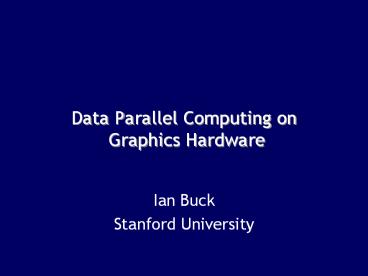Data Parallel Computing on Graphics Hardware PowerPoint PPT Presentation
Title: Data Parallel Computing on Graphics Hardware
1
Data Parallel Computing on Graphics Hardware
- Ian Buck
- Stanford University
2
Why graphics hardware
- Raw Performance
- Pentium 4 SSE Theoretical
- 3GHz 4 wide .5 inst / cycle 6 GFLOPS
- GeForce FX 5900 (NV35) Fragment Shader Obtained
- MULR R0, R0, R0 20 GFLOPS
- Equivalent to a 10 GHz P4
- And getting faster 3x improvement over NV30 (6
months) - 2002 RD Costs
- Intel 4 Billion
- NVIDIA 150 Million
GeForce FX
from Intel P4 Optimization Manual
3
GPU Data Parallel
- Each fragment shaded independently
- No dependencies between fragments
- Temporary registers are zeroed
- No static variables
- No Read-Modify-Write textures
- Multiple pixel pipes
- Data Parallelism
- Better ALU usage
- Hide Memory Latency
- Torborg and Kajiya 96, Anderson et al. 97,
Igehy et al. 98
4
Arithmetic Intensity
- Lots of ops per word transferred
- Graphics pipeline
- Vertex
- BW 1 triangle 32 bytes
- OP 100-500 f32-ops / triangle
- Rasterization
- Create 16-32 fragments per triangle
- Fragment
- BW 1 fragment 10 bytes
- OP 300-1000 i8-ops/fragment
Courtesy of Pat Hanrahan
5
Arithmetic Intensity
- Compute-to-Bandwidth ratio
- High Arithmetic Intensity desirable
- App limited by ALU performance, not off-chip
bandwidth - More chip real estate for ALUs, not caches
Courtesy of Bill Dally
6
BrookGeneral purpose Streaming language
- Stream Programming Model
- Enforce Data Parallel computing
- Encourage Arthithmetic Intensity
- Provide fundamental ops for stream computing
7
BrookGeneral purpose Streaming language
- Demonstrate GPU streaming coprocessor
- Virtualize the GPU
- Hide texture/pbuffer data management
- Hide graphics based constructs in CG/HLSL
- Hide rendering passes
- Highlight GPU areas for improvement
- Features required general purpose stream
computing
8
Streams Kernels
- Streams (Data)
- Collection of records requiring similar
computation - Vertex positions, voxels, FEM cell,
- Provide data parallelism
- Kernels (Functions)
- Functions applied to each element in stream
- transforms, PDE,
- No dependencies between stream elements
- Encourage high Arithmetic Intensity
9
Brook
- C with Streams
- Simple language additions for streams/kernels
- API for managing streams
- Streams
- float slt200,100gt
- streamread (s, ptr)
- streamwrite (s, ptr)
10
Brook
- Kernel Functions
- Map a function to a set
- pos update in velocity field
- kernel void updatepos (float3 posltgt,
- float3 vel100,100,100,
- float timestep,
- out float newposltgt)
- newpos pos velpostimestep
- updatepos (pos, vel, timestep, pos)
11
Fundamental Ops
- Associative Reductions
- MyReduceFunc (s, result)
- Produce a single value from a stream
- Examples Compute Max or Sum
8 6 3 7 2 9 0 5
40
12
Fundamental Ops
- Gather p ai
- Indirect Read
- Permitted inside kernels
- Scatter ai p
- Indirect Write
- ScatterOp(s_index, s_data, s_dst,
SCATTEROP_ASSIGN) - Last write wins rule
13
GatherOp ScatterOp
- Indirect read/write with atomic operation
- GatherOp p ai
- GatherOp(s_index, s_data, s_src, GATHEROP_INC)
- ScatterOp ai p
- ScatterOp(s_index, s_data, s_dst,
SCATTEROP_ADD) - Important for building and updating data
structures for data parallel computing
14
Implementation
- Streams
- Stored in 2D fp textures / pbuffers
- Allocation at compile time
- Managed by runtime
- Kernels
- Compiled to fragment programs
- Executed by rendering quad
15
Implementation
- Compiler brcc
- Source to Source compiler
- Generate CG/HLSL code
- Convert array lookups to texture fetches
- Perform stream/texture lookups
- Texture address calculation
- Generate C Stub file
- Fragment Program Loader
- Render code
- Targets
- NV fp30, ARB fp, ps2.0
foo.br
foo.cg
foo.fp
foo.c
16
Implementation
- Reduction
- O(lg(n)) Passes
- Gather
- Dependent texture read
- Scatter
- Vertex shader (slow)
- GatherOp / ScatterOp
- Vertex shader with CPU sort (slow)
17
Gromacs
- Molecular Dynamics Simulator
Eric Lindhal, Erik Darve, Yanan Zhao
Force Function (90 compute time)
Acceleration Structure
Energy Function
18
Ray Tracing
Tim Purcell, Bill Mark, Pat Hanrahan
19
Finite Volume Methods
Joseph Teran, Victor Ng-Thow-Hing, Ronald Fedkiw
20
Applications
- Gromacs, Ray Tracing
- Reduce, Gather, GatherOp, ScatterOp
- FVM, FEM
- Reduce, Gather
- Sparse Matrix Multiply, Batcher Bitonic Sort
- Gather
21
GPU Gotchas
Time
Registers Used
- NVIDIA NV3x Register usage vs. GFLOPS
22
GPU Gotchas
- ATI Radeon 9800 Pro
- Limited dependent texture lookup
- 96 instructions
- 24-bit floating point
Texture Lookup
Math Ops
Texture Lookup
Math Ops
Texture Lookup
Math Ops
Texture Lookup
Math Ops
23
GPU Issues
- Missing Integer Bit Ops
- Texture Memory Addressing
- Need large flat texture addressing
- Readback still slow
- Shader compiler performance
- Hand code performance critical code
- No native reduction support
24
GPU Issues
- No native Scatter Support
- Cannot do pia (indirect write)
- Needs
- Dependent Texture Write
- Set x,y inside fragment program
- No programmable blend
- GatherOp / ScatterOp
- Limited Output
25
Status
- In progress
- NV30 prototype working
- Scheduled public release date
- December 15, 2003
- SourceForge
- Stanford Streaming Supercomputer
- Cluster version
26
Summary
- GPUs are faster than CPUs
- and getting faster
- Why?
- Data Parallelism
- Arithmetic Intensity
- What is the right programming model?
- Stream Computing
- Brook for GPUs
27
Summary
- All processors aspire to be general-purpose
- Tim van Hook, Keynote, Graphics Hardware 2001

